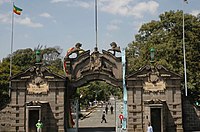 |
University |
Source: WikipediaAddis Ababa University (AAU) (Amharic: አዲስ አበባ ዩኒቨርሲቲ) is a large, highly residential national university in Addis Ababa, Ethiopia. The university is the oldest school of higher education in Ethiopia. AAU has thirteen campuses. Twelve of these are situated in Addis Ababa, and one is located in Bishoftu (Debre Zeit), about 45 kilometres (28 mi) away. AAU has several associated research institutions including the Institute of Ethiopian Studies. The Ministry of Education admits qualified students to AAU based on their score on the Ethiopian University Entrance Examination (EUEE).
History
The origins of AAU was a two-year college in 1950 by Dr Lucien Matte, S.J., at the appeal of His Majesty Emperor Haile Selassie I. It began operations the following year. Over the following two years an affiliation with the University of London was developed.
The nucleus of AAU was formed with the establishment of the University College of Addis Ababa (UCAA) in 1950. UCAA, which initially consisted of the Faculties of Arts and Science, became a fully fledged college when it was chartered in 1954. In 1955, the Building College was opened. In February 1961, these various colleges and the Theological College were brought together to form the Haile Selassie University. Emperor Haile Selassie I gave his Guenete Leul Palace to serve as the administration building and main campus. He had abandoned the palace, where a number of his ministers and favorites were killed in the wake of the abortive Coup d'état in 1960, in favor of the new Jubilee Palace. Following the 1974 revolution, the university was briefly renamed University of Ethiopia (National University) before it came to assume its present designation, AAU, in 1975. In the wake of the revolution, AAU was closed for two years and students and staff were drafted into what was known as the Development through Cooperation Campaign (zemecha), designed to arise the awareness of the rural population in the spirit of the revolution. The university offered its first Master's programs in 1979 and its first PhD programs in 1987.
Administration
Until 1974 the charter provided for a governance structure in the following descending order or authority: Chancellor (the Emperor himself); the Board of Governors, composed of ministers and members of the royal family; and the Faculty Council, made up of the university officers, deans, directors and elected members. The Faculty later became the Senate. In 1977, the AAU lost its relative autonomy when it was brought under the Commission for Higher Education, which came to exercise administrative jurisdiction over all institutions of higher learning. In 1993, AAU was placed under the Ministry of Education by a government proclamation.
Influence
Over and above their academic pursuits, AAU students have been actively engaged in community service (such as conducting literacy programs) and political struggle, particularly in the years before the 1974 revolution. In the late 1960s and early 1970s, students were required to do a year of national service under the Ethiopia University Service program. University teachers and students were instrumental in exposing the hidden 1973 famine and launching the first famine relief program. The Ethiopian Student Movement, of which the University was the birthplace and main venue, played a pivotal role in bringing about the revolution. Almost all leaders of the political organizations that were active in the revolutionary years or are in power now had their political formation inside the University. In 2013/2014, there were 33,940 undergraduate students, 13,000 graduate students, and 1,733 PhD students, making a total student body of 48,673.
Campuses and colleges
Colleges
Research and Teaching Institutes
Schools
Notable alumni
References
External links
Addis Ababa University official website
Institute of Ethiopian Studies and the Ethnological Museum
Contact information for Addis Ababa University, and 28 Ethiopian institutions of higher education in the African Higher Education Database






 Deutsch
Deutsch English
English Español
Español data-image="https://upload.wikimedia.org/wikipedia/commons/thumb/3/3a/Addis_Abeba_University.jpg/500px-Addis_Abeba_University.jpg"
data-title="Author: VBzi, Licence: CC BY 2.0, Source: Wikimedia Commons"
data-image="https://upload.wikimedia.org/wikipedia/commons/thumb/3/3a/Addis_Abeba_University.jpg/500px-Addis_Abeba_University.jpg"
data-title="Author: VBzi, Licence: CC BY 2.0, Source: Wikimedia Commons"




